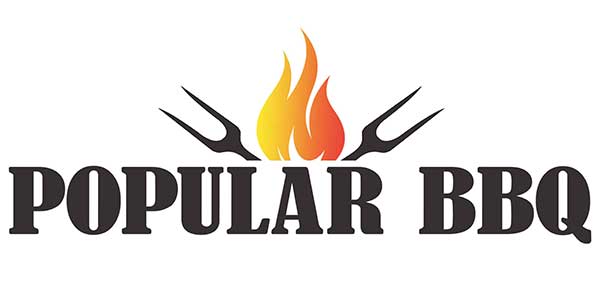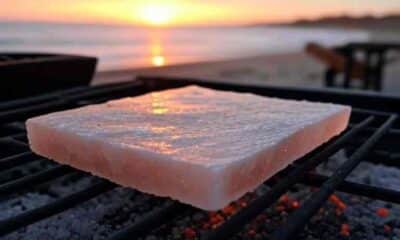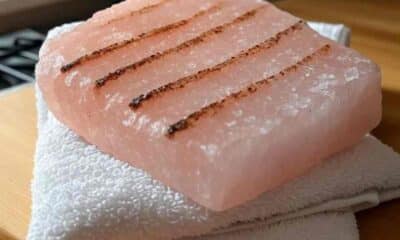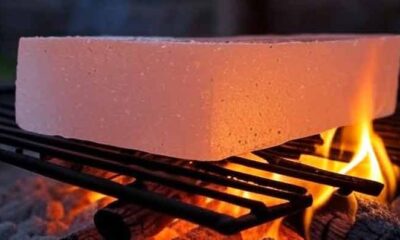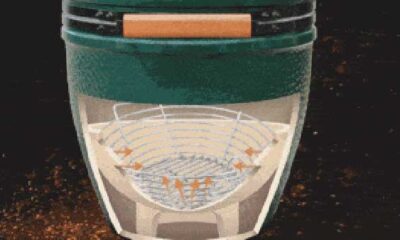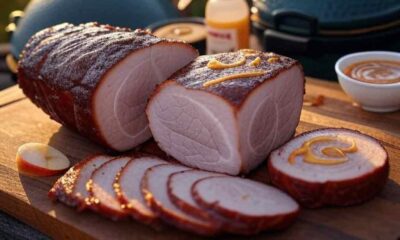BBQ Tips & Tricks
Himalayan Salt Block Grilling: Your Guide to the Salt Life
Himalayan Salt Block Grilling: A Coastal Cook’s Guide
As a coastal cook shaped by the briny air of Newport, Rhode Island, I find Himalayan salt block grilling transforms my Cannon Beach BBQs into celebrations of flavor, infusing dishes with a gentle, sea-kissed essence that recalls my father’s lobster traps. These pink slabs, mined from Pakistan’s ancient Khewra Salt Mine, aren’t just beautiful—they add a unique coastal touch that makes guests swoon. I’m excited to share how to grill and smoke with Himalayan salt blocks, plus creative ideas to make your BBQ the talk of the town. Let’s dive into this coastal adventure and get grilling!

Mia ‘The Coastal Catch’ elevates a beach BBQ with a Himalayan salt block, grilling shrimp and veggies at sunset.
Why Himalayan Salt Block Grilling is a Game-Changer
These rosy slabs are more than a pretty addition to your grill—they’re a coastal cook’s dream. Here’s why Himalayan salt block grilling is a must-have:
- Natural Seasoning: The block’s moisture dissolves salt, adding a delicate, balanced salinity that feels like a coastal breeze on your shrimp or scallops.
- Even Heat: Its crystal structure distributes heat evenly, ensuring perfect cooks for asparagus or thin fish fillets every time.
- Non-Stick Magic: Food lifts easily, making flipping and serving a breeze, especially for delicate seafood.
- Hygienic: High heat and natural salinity kill bacteria, offering a clean cooking surface for your BBQ.
- Showstopper Looks: The pink glow turns your grill into a visual feast, perfect for coastal gatherings.
- Hot or Cold: Holds temperatures for hours, ideal for grilling at 500°F or chilling sushi platters.
- Health Perks: Packed with trace minerals like calcium and magnesium, it’s a natural choice, though sodium levels are similar to table salt.
In my Shoreline Smoke dinners, I use the block’s even heat for quick-searing shrimp, and its hygienic properties give me peace of mind. Choose a block at least 1.5 inches thick for durability, and pair with alderwood smoke for a coastal flavor boost, as I do in my Oregon kitchen. These benefits make Himalayan salt block grilling a game-changer for any BBQ.
Creative Ways to Use Your Salt Block
Ready to elevate your BBQ? Here are coastal-inspired ideas for Himalayan salt block grilling:
- Interactive Dining: Heat to 500°F and let guests sear their own shrimp or scallops at the table, creating a fun, communal vibe.
- Chilled Platters: Chill in the freezer for 2–3 hours to serve sushi, ceviche, or a beachy salad, keeping dishes crisp and cool.
- Grind It Up: When worn, grind into coarse pink salt for seasoning seafood boils or grilled vegetables.
- Cure Like a Pro: Use to cure salmon or tuna, infusing a briny depth for a coastal treat that stores well.
Pro Tip: Designate a “top” and “bottom” side to reduce stress on natural fissures, as advised by FoodFireFriends. In my workshops, I chill blocks for raw oyster platters, enhancing their briny flavor, or grind worn pieces for a sustainable finishing salt. These ideas make Himalayan salt block grilling endlessly versatile.
Common Uses for Himalayan Salt Block Grilling
Himalayan salt block grilling shines for a variety of dishes:
- Seafood: Sear scallops (2–3 minutes per side at 450°F), shrimp (1–2 minutes), or thin fish fillets for a salty crust that screams coastal.
- Veggies: Grill asparagus, zucchini, or bell peppers at 400°F for 3–4 minutes per side for a light, flavorful side.
- Meats: Perfect for flank steaks or pork chops, seared at 500°F for 2–3 minutes per side for a killer crust.
- Fruit: Try pineapple or peaches at 400°F for 2–3 minutes for a sweet-salty twist.
- Smoking: Add to your smoker for a subtle briny boost to salmon or chicken.
- Chilling: Serve cold shrimp cocktail or fruit on a chilled block for hot summer days.
Tips: Use dry, unsalted food cut uniformly to ensure even cooking. Heat slowly (15 minutes low, 15 minutes medium, high to 500°F) to avoid cracks. Skip marinated meats—they can crack the block and oversalt dishes. In my coastal BBQs, I use a fish spatula for delicate flips and pair with unsalted sides like quinoa to balance flavors. These practices enhance your Himalayan salt block grilling experience.
How to Care for Your Salt Block
Proper care keeps your salt block thriving for years:
- Heating: Preheat gradually—15 minutes each on low, medium, and high to reach 500°F—to prevent cracking.
- Cooling: Cool completely for 12–24 hours on a heat-safe surface to avoid thermal shock.
- Cleaning: Use minimal warm water and a stainless steel scrubber, dry immediately, and air-dry on a rack. Avoid soap to preserve salinity.
- Storage: Keep dry, wrapped in a cotton cloth in humid areas like my Oregon cottage, and allow 24 hours drying between uses.
When the block wears out, grind it into salt for your next seafood boil, a sustainable trick I love. Our care guide offers more details. In my kitchen, I store the block with silica packets to combat coastal humidity, ensuring it’s ready for the next BBQ.
Common Questions Answered
Got questions about Himalayan salt block grilling? Here’s what I’ve learned:
- Are salt blocks hygienic?
- Yes! High heat and salinity kill bacteria, making them a safe cooking surface.
- What size should I get?
- An 8” x 12” x 2” block is great for multiple items; 4” x 8” x 2” suits smaller meals. Aim for 1.5” thickness for durability.
- Will flavors transfer between foods?
- Not if cleaned properly—no taste carryover, per FoodFireFriends.
- How long do they last?
- Years with care. When cracked, grind into salt for cooking.
- Can I use marinated meats?
- Avoid them—marinades can crack the block and make food too salty.
- How do I check the temperature?
- Water should sizzle and vanish, or use an infrared thermometer for 500°F.
- Do they change when heated?
- They pale and may crack, but the pink often returns when cooled—normal behavior.
- Where can I buy one?
- Amazon offers various sizes for easy purchasing.
Sustainability and Ethical Practices
Sustainability is close to my heart for Himalayan salt block grilling. Choose blocks from ethical sources like the Khewra Salt Mine, where some companies use solar-powered equipment and recycle water to reduce environmental impact. Pair with MSC-certified seafood from the Marine Stewardship Council to protect oceans. Repurpose worn blocks as finishing salt for grilled fish, minimizing waste, as I do in my workshops.
Store blocks in a dry cloth with silica packets to combat humidity, and use minimal oil during grilling to align with eco-conscious values. These practices, rooted in my love for the sea, ensure Himalayan salt block grilling honors the earth, making each BBQ a sustainable celebration.
Troubleshooting Common Issues
To perfect Himalayan salt block grilling, avoid pitfalls:
- Cracking: Prevent with slow heating—30 minutes total to reach 500°F. Cool for 12–24 hours.
- Over-salting: Use quick-cooking foods like shrimp (1–2 minutes per side) and unsalted sides to balance flavors.
- Sticking: Oil food lightly, not the block, and use a fish spatula for easy flips.
- Uneven Heating: Spread charcoal evenly or adjust gas burners, rotating the block for uniform heat.
Our troubleshooting guide offers more fixes. In my coastal BBQs, I test salinity with a small piece of seafood and ensure even heat with a thermometer, keeping dishes flawless.
Wrap-Up: Make Waves at Your Next BBQ with Himalayan Salt Block Grilling
Himalayan salt block grilling is your ticket to a coastal-inspired BBQ that’s as delicious as it is stunning. From searing shrimp to chilling ceviche, these blocks bring flavor, flair, and sustainability to your grill. Heat slowly, clean carefully, and let your creativity soar. In my Oregon home, where my dog Briny naps by the fire, the block recalls my Rhode Island summers, weaving the sea’s story into every dish. Ready to make waves? Grab a salt block and share your coastal catch in the comments below!
Happy Grilling!
Mia, The Coastal Catch

